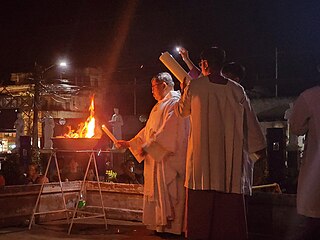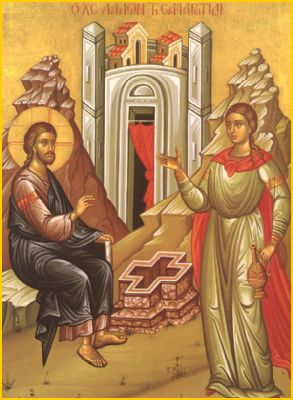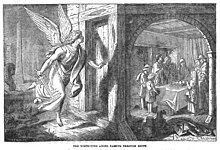
Easter, also called Pascha or Resurrection Sunday, is a Christian festival and cultural holiday commemorating the resurrection of Jesus from the dead, described in the New Testament as having occurred on the third day of his burial following his crucifixion by the Romans at Calvary c. 30 AD. It is the culmination of the Passion of Jesus Christ, preceded by Lent, a 40-day period of fasting, prayer, and penance.

The Eucharist, also known as Holy Communion, Blessed Sacrament and the Lord's Supper, is a Christian rite that is considered a sacrament in most churches, and as an ordinance in others. Christians believe that the rite was instituted by Jesus at the Last Supper, the night before his crucifixion, giving his disciples bread and wine. Passages in the New Testament state that he commanded them to "do this in memory of me" while referring to the bread as "my body" and the cup of wine as "the blood of my covenant, which is poured out for many". According to the Synoptic Gospels this was at a Passover meal.

In Catholic theology, Limbo is the afterlife condition of those who die in original sin without being assigned to the Hell of the Damned. Medieval theologians of Western Europe described the underworld as divided into three distinct parts: Hell of the Damned, Limbo of the Fathers or Patriarchs, and Limbo of the Infants. The Limbo of the Fathers is an official doctrine of the Catholic Church, but the Limbo of the Infants is not. The concept of Limbo comes from the idea that, in the case of Limbo of the Fathers, good people were not able to achieve heaven just because they were born before the birth of Jesus Christ. This is also true for Limbo of the Infants in that simply because a child died before baptism, does not mean they deserve punishment, though they cannot achieve salvation.

The liturgical year, also called the church year, Christian year or kalendar, consists of the cycle of liturgical seasons in Christian churches that determines when feast days, including celebrations of saints, are to be observed, and which portions of Scripture are to be read either in an annual cycle or in a cycle of several years.

Holy Week is the most sacred week in the liturgical year in Christianity. For all Christian traditions, it is a moveable observance. In Eastern Christianity, which also calls it Great Week, it is the week following Great Lent and Lazarus Saturday, starting on the evening of Palm Sunday and concluding on the evening of Great Saturday. In Western Christianity, Holy Week is the sixth and last week of Lent, beginning with Palm Sunday and concluding on Holy Saturday.

Melito of Sardis was the bishop of Sardis near Smyrna in western Anatolia, and who held a foremost place among the early Christian bishops in Asia due to his personal influence and his literary works, most of which have been lost. What has been recovered, however, has provided a great insight into Christianity during the second century. Jerome, speaking of the Old Testament canon established by Melito, quotes Tertullian to the effect that he was esteemed as a prophet by many of the faithful. This work by Tertullian has been lost, but Jerome quotes sections regarding Melito for the high regard in which he was held at that time. Melito is remembered for his work on developing the first Old Testament Canon. Though it cannot be determined what date he was elevated to the episcopacy, it is probable that he was bishop during the controversy that arose at Laodicea in regard to the observance of Easter, a controversy that led to his writing his most famous work, an Apology for Christianity to Marcus Aurelius. Little is known of his life outside the works which were quoted or had been read by Clement of Alexandria, Origen, and Eusebius.

Holy Saturday, also known as Great and Holy Saturday, Low Saturday, the Great Sabbath, Hallelujah Saturday, Saturday of the Glory, Sábado de Gloria, and Black Saturday or Easter Eve, and called "Joyous Saturday", "the Saturday of Light", and "Mega Sabbatun" among Coptic Christians, is the final day of Holy Week, between Good Friday and Easter Sunday, when Christians prepare for the latter.
Quartodecimanism is the name given to the practice of celebrating the death of Christ on the day of Passover, the 14th of Nisan according to biblical dating, on whatever day of the week it occurs. The Quartodeciman controversy in the Church was the question of whether to celebrate Easter on Sunday, or on Passover.

An artos is a loaf of leavened bread that is blessed during services in the Eastern Orthodox and Byzantine rite catholic churches. A large Artos is baked with a seal depicting the resurrection for use at Pascha (Easter). Smaller loaves are blessed during great vespers in a ritual called Artoklasia and in other occasions like feast days, weddings, memorial services etc.

The Easter Vigil, also called the Paschal Vigil, the Great Vigil of Easter, or Holy Saturday in the Easter Vigil on the Holy Night of Easter is a liturgy held in traditional Christian churches as the first official celebration of the Resurrection of Jesus. Historically, it is during this liturgy that people are baptized and that adult catechumens are received into full communion with the Church. It is held in the hours of darkness between sunset on Holy Saturday and sunrise on Easter Day – most commonly in the evening of Holy Saturday or midnight – and is the first celebration of Easter, days traditionally being considered to begin at sunset.

The sacraments of initiation are the three sacraments of Baptism, Confirmation, and Eucharist in Nicene Christianity. As such, they are distinguished from the sacraments of healing and from the sacraments of service.

Eucharistic theology is a branch of Christian theology which treats doctrines concerning the Holy Eucharist, also commonly known as the Lord's Supper and Holy Communion. It exists exclusively in Christianity, as others generally do not contain a Eucharistic ceremony.

Eucharist is the name that Catholic Christians give to the sacrament by which, according to their belief, the body and blood of Christ are present in the bread and wine consecrated during the Catholic eucharistic liturgy, generally known as the Mass. The definition of the Eucharist in the 1983 Code of Canon Law as the sacrament where Christ himself "is contained, offered, and received" points to the three aspects of the Eucharist according to Catholic theology: the real presence of Christ in the Eucharist, Holy Communion, and the holy sacrifice of the Mass.
Fasika (Ge'ez: ፋሲካ, sometimes transcribed as Fasica; [ultimately from Aramaic פַּסְחָא ] is the Ge'ez, Amharic, and Tigrinya word for Easter, also called Tensae.

The Pentecostarion is the liturgical book used by the Eastern Orthodox and Byzantine Catholic churches during the Paschal Season which extends from Pascha (Easter) to the Sunday following All Saints Sunday.
Catholic theology is the understanding of Catholic doctrine or teachings, and results from the studies of theologians. It is based on canonical scripture, and sacred tradition, as interpreted authoritatively by the magisterium of the Catholic Church. This article serves as an introduction to various topics in Catholic theology, with links to where fuller coverage is found.

Peri Pascha is a 2nd-century homily of Melito of Sardis written between A.D.160 and 170 in Asia Minor. It was discovered last century and first published in 1940. It describes Christian doctrine on the Paschal mystery in the style of Second Sophistic period. It was originally conjectured to have probably been recited with the kind of cantillation customary in scripture reading. Its first editor, Campbell Bonner, entitled it mistakenly On the Passion. It was corrected to On the Pascha, thanks to the title found in the Papyrus Bodmer XIII, one of the Bodmer Papyri.

There are seven sacraments of the Catholic Church, which according to Catholic theology were instituted by Jesus Christ and entrusted to the Church. Sacraments are visible rites seen as signs and efficacious channels of the grace of God to all those who receive them with the proper disposition.

A sacrament is a Christian rite that is recognized as being particularly important and significant. There are various views on the existence, number and meaning of such rites. Many Christians consider the sacraments to be a visible symbol of the reality of God, as well as a channel for God's grace. Many denominations, including the Roman Catholic, Lutheran, Presbyterian, Anglican, Methodist, and Reformed, hold to the definition of sacrament formulated by Augustine of Hippo: an outward sign of an inward grace, that has been instituted by Jesus Christ. Sacraments signify God's grace in a way that is outwardly observable to the participant.
History according to the Catholic Church is the theological interpretation of humanity's and Israel's past as recorded in the Bible, the present times, and the future of the world by the Catholic Church. It is not the same as a timeline of the Catholic Church or an ecclesiastical history of the Catholic Church, but the church's perspective on history - in other words, a combination of Catholic origin myth and eschatology. In academic theology, the field of Church history develops and contributes to the Catholic Church's understanding of history. The church believes its foundation by Jesus marks the end-times, because Judaism believes that the messiah will come in the end-times. While the church accepts much of the Jewish interpretation of the Old Testament - the existence of God, divine inspiration, the exodus to the promised land, Babylonian captivity, etc. - the church does not agree with everything Judaism believes. The church interprets many scriptural events literally, applies the messianic prophecies to Jesus, and applies Jewish self-identity to the church. For example, where Judaism believes that the world was created for the sake of Israel, the church teaches that the world was created for the sake of the New Israel ; and where Judaism is centered on God and his Torah, the church is Christocentric. This article divides Catholic perspectives into two pieces: official interpretations, as presented in the Catechism of the Catholic Church, and unofficial interpretations, as presented by certain media.

















